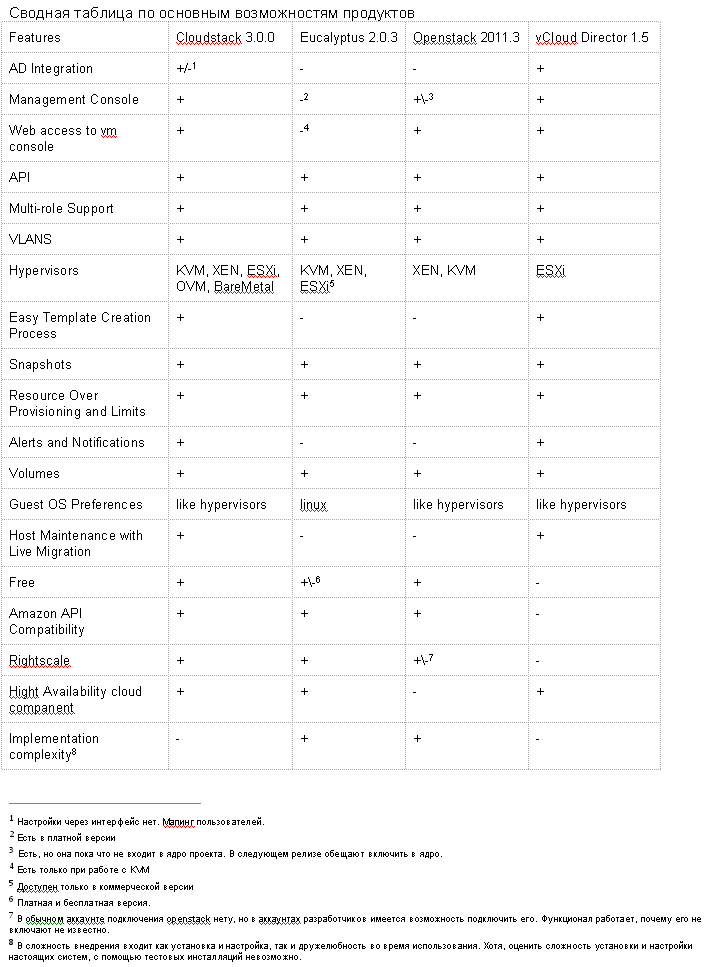Cloud Platform Overview

Probably everyone is already fed up with these very clouds, but briefly we’ll dwell on what they happen to if someone does not know. Depending on the deployment model, they are:
- private cloud
- public cloud
- hybrid cloud
More details can be found here .
Depending on the service model:
So, today we are going to talk about platforms for building IaaS clouds. Go!

Cloudstack 3.0.0
Description
Cloudstack is a data center management console for your datacenter. Such large companies as Zynga, Nokia Research Center, Cloudcentral and others built their clouds on this platform. The development of the project is carried out by Citrix. The platform has its own API, which allows you to configure and integrate the platform with the existing infrastructure, and using the CloudBridge Amazon EC2 adapter you can convert the Amazon API to the Cloudstack API. A full list of commands supported by the adapter can be found here . The main features of the platform:
- Hypervisors Agnostic (KVM, XEN, ESXi, OVM, BareMetal)
- Roles
- Virtual network
- Resource pool
- Snapshots and volumes
- Virtual routers, firewall and load balancer
- Live Migration with host maintenance
When working with the ESXi hypervisor, the platform uses the vCenter API. Thus, the implementation of the platform in the existing infrastructure built on VMware will be easy.
')
Cost of
The best part is that at the moment Cloudstack is free and distributed under the GNU Public License Version 3 license. If you are interested in paid support, then you need to contact the developers via email for information.
Community
There may be many problems during the installation of the platform. You can try to solve them by contacting the community. The forum discusses many questions and helps to solve them. There is an IRC channel where you can also ask questions.
Documentation
Probably an important element in all products is documentation . It determines how easy it will be for a user to log in to this technology. The simpler and clearer the documentation, the greater the chance that any interested person will be able to install the platform. If you have a certain background, then you will easily carry out a simple installation of the platform, this is enough for familiarization. A more complex installation and planning of architecture will take a lot of time, in the documentation not all features are disclosed. The documentation is made in the step by step style and does not describe how the platform works. Part of the knowledge will come to you only after the actual use of the platform.
Experience
Basic installation and configuration. Using VMware clusters and kvm clusters. CentOS 6.2 was used as the operating system. Successfully connected our cloud to the management console from Rightscale. When using CentOS 6, there may be problems running libvirtd. To solve these problems, add in /etc/cgconfig.conf:
group virt {
cpu {
cpu.shares = 9216;
}
}After that we do /etc/init.d/cgconfig restart and try to run libvirtd.
There may also be problems with the console through the site. One of the problems is that the vnc server on the hosts runs at 127.0.0.1 address. To test run:
netstat -nlp | grep kvm
tcp 0 0 0.0.0.0:5900 0.0.0.0:* LISTEN 11673/qemu-kvm
tcp 0 0 0.0.0.0:5901 0.0.0.0:* LISTEN 11872/qemu-kvm
tcp 0 0 0.0.0.0:5902 0.0.0.0:* LISTEN 15227/qemu-kvm
tcp 0 0 0.0.0.0:5903 0.0.0.0:* LISTEN 12587/qemu-kvmIf you have the address 127.0.0.1 after executing this command, you need to uncomment the line in the /etc/libvirt/qemu.conf file:
vnc_listen = "0.0.0.0"and restart virtual machines.
findings
Very interesting cloud management console. Excellent functionality, free and quickly developing. You can integrate it into real infrastructure, but if we use only ESXi hypervisors, then vCloud Director is the best option.

Eucalyptus Open Source 2.0.3
Description
Eucalyptus is another cloud building platform. Their Private Cloud, built on this platform, such large companies as: Sony, Puma, NASA, Trend micro and others. There are 2 editions of Eucalyptus: paid and free. In these versions, the functionality is very different. The main advantage that Eucalyptus is trying to convey to users is that its API is fully compatible with the Amazon API. That is, all the scripts and programs that work with the Amazon API can be used for your cloud, built on the Eucalyptus platform. Eucalyptus supports 3 hypervisors: XEN, KVM, ESXi. The latest (ESXi) is supported only in the Enterprise version.
Main advantages:
- Roles
- Hypervisor agnostic
- Clustering and Zonning
- Flexible Network Management, Security Groups, Traffic Isolation
Cost of
As I wrote above, there is a free and paid version. Eucalyptus open source and Ecalyptus Enterprise Cloud. The differences between the versions can be found here.
Community
I did not manage to rate the community of this product. Everything was established without any problems.
Documentation
The product has installation documentation, but it does not disclose all aspects. It is assumed that a person has a large background. There are no virtualization settings at all. At installation of more difficult configuration documentation will not help, it is worth relying only on the competence.
Experience
Installation, setting documentation. CentOS 5.5 was used as the operating system for the cloud controller, CentOS 5.5 with the XEN hypervisor was selected as the operating system for the host. Also connected our cloud to Rightscale. As such, there is no management console, so you have to either manage it with euca2tools or connect it to RightScale. Although, in the paid version has its own management console. During installation, the following problems occurred:
1) When installing some dependencies in turn, they refused to be installed. The solution was to install dependencies in one go.
rpm -Uvh python25-2.5.1-bashton1.x86_64.rpm
error: Failed dependencies:
libpython2.5.so.1.0()(64bit) is needed by python25-2.5.1-bashton1.x86_64Decision:
rpm -Uvh python25-2.5.1-bashton1.x86_64.rpm python25-devel-2.5.1-bashton1.x86_64.rpm python25-libs-2.5.1-bashton1.x86_64.rpm2) After installing the platform when starting the controller, these errors may occur:
/etc/init.d/eucalyptus-cc start
Starting Eucalyptus cluster controller:
Enabling IP forwarding(13)Permission denied: make_sock: could not bind to address [::]:8774
(13)Permission denied: make_sock: could not bind to address 0.0.0.0:8774
no listening sockets available, shutting down
Unable to open logs
Failed to start the CC!To solve the problem, turn off Selinux.
3) If you do not have enough experience with XEN, then you may have problems using it. It is necessary after installing XEN in /etc/grub/menu.lst correct default = 1 -> default = 0 to boot the kernel with XEN.
4) Also in CentOS, you need to create the libvirt group and add the user from whom eucalyptus works.
findings
It's damp somehow. The free version is not very actively developing. There are problems. Perhaps the commercial version is much better. During the research platform, we made a request for a trial version of a commercial product, but failed to evaluate the functionality of the commercial version.

vCloud Director 1.5
Description
vCloud Director is a cloud building platform from VMware. If your entire infrastructure is built on a VMware product, then implementing vCloud Director will be the ideal solution. vCloud Director allows you to build truly hybrid clouds. With VMware vCloud Connector, you can migrate your virtual machines between your public cloud and private cloud. Key Features:
- Virtual datacenters
- vShield Security Technologies
- Infrastructure Service Catalog
- Multi-tenant Organizations
- Self-service Portal
- VMware vCloud API, Open Virtualization Format, and Callouts
Cost of
Paid. In order to find out the approximate price of the package that suits you, you need to contact regional managers.
Community
Due to the fact that VMware is a market leader it has a great community . Excellent support in the form of knowledge base. Do not forget about paid support and support after purchasing products from VMware.
Documentation
Paid products always have good documentation . And as practice has shown, if you follow it, the installation will take place without problems.
Experience
Install and configure vCloud Director. To install the very vCloud Director you need Red Hat. There are also components without which vCloud Director will not be installed:
- vCenter (with clusters and DRS)
- vShield
It is not difficult to guess that the vCloud Director is used by the vCenter API. Accordingly, we get with you all the functionality of vSphere if you build your cloud using vCloud Director.
findings
The main disadvantage is that it is paid, but if you already use virtualization from VMware, then vCloud Director is the ideal option for you.

Openstack 2011.3
Description
Openstack 2011.3 is an open source platform for building clouds. The Openstack project includes 3 products: Nova (analog of Amazon EC2), Swift (analog of Amazon S3), Glance (service for providing images). In our comparison, we will consider only the Nova, but you should pay attention to Swift - the product is unique in its kind and many products integrate with it (Cloudstack 3). At the moment, Nova maintains a decent level 2 hypervisor: KVM and XEN. The platform is developing rapidly and promises great functionality. It has a huge community and support from such corporations as: Cisco, Dell, NASA, Intel, AMD, Citrix, Rackspace, Rightscale. The main core of Openstack has become the product of the Nebula, developed by NASA. Key Features:
- Manage virtualized commodity server resources
- Manage Local Area Networks
- Virtual Machine (VM) image management
- Security Groups
- Role Based Access Control
- Projects & Quotas
- VNC Proxy through web browser
Cost of
The product is completely free, open source, but do not forget to help the community in product development.
Community
In my opinion, Openstack, of all the platforms we are considering, is the largest and most active community . Due to the fact that the product is actively developing with it a lot of problems and very often people help to solve these problems.
Documentation
Openstack has problems with documentation . Due to the rapid development of the product, the documentation simply does not have time to be updated. Many important things are not there and you have to find out on the forums or on IRC .
Experience
Basic installation and setup of Nova, keystone, dashboard. For virtualization, we used KVM.
findings
The platform is free and is developing rapidly, but still too raw. To embed it in real infrastructure, you need a team of Python developers who will bring it to mind. If you have any ideas for Amazon, then compatibility with Amazon API will help you. In the project incubator there is an Openstack Dashboard, which does not always provide 100% functionality due to API rework.
Summary table for the main features of the products

Source: https://habr.com/ru/post/140375/
All Articles